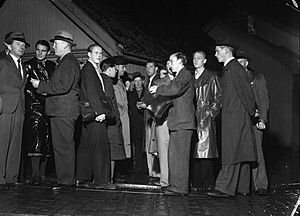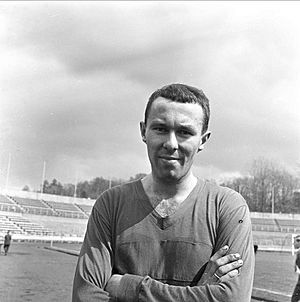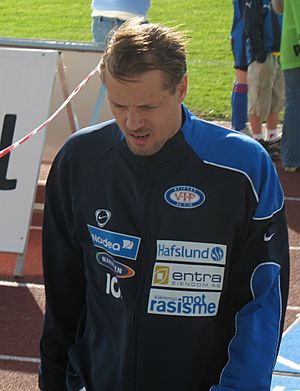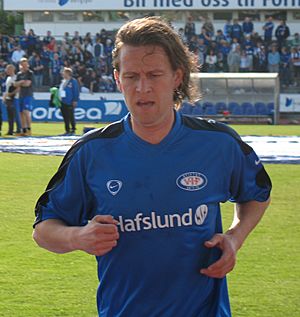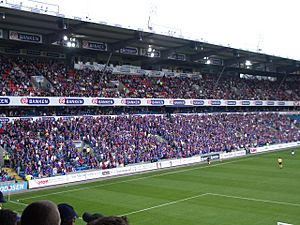Vålerenga Fotball facts for kids
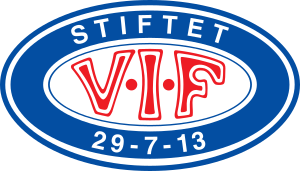 |
||||
| Full name | Vålerenga Fotball | |||
|---|---|---|---|---|
| Nickname(s) | Enga Bohemene (The Bohemians) De kongeblå (The Royal Blues) St. Hallvards menn (St. Hallvard’s Men) |
|||
| Short name | VIF | |||
| Founded | 29 July 1913 | |||
| Ground | Intility Arena Valle Hovin, Oslo |
|||
| Capacity | 16,555 | |||
| Chairman | Thor Gjermund Eriksen | |||
| Head coach | Geir Bakke | |||
| League | Eliteserien | |||
| 2024 | First Division, 1st of 16 (promoted) | |||
|
||||
Vålerenga Fotball (Norwegian pronunciation: [ˈvôːɽɛŋɑ]) is a professional football club from Oslo, Norway. It is part of the larger Vålerengens IF sports club. The team currently plays in the Eliteserien, which is Norway's top football league. They were promoted back to this league in 2024.
Vålerenga was started in 1913 and is named after the Vålerenga neighborhood in Oslo. Their home stadium is Intility Arena, located in Valle Hovin. Vålerenga has won the league five times and the Norwegian Football Cup four times. Their last league win was in 2005, and their last cup win was in 2008. Many people consider Vålerenga to be the biggest football club in Oslo, and they are famous for their dedicated fans.
Contents
Club History: From Early Days to Today
How Vålerenga Started (1913–1945)
The story of Vålerenga Fotball began with a football group called Fotballpartiet Spark in 1898. It was started by a pastor named Hans Møller Gasmann. He wanted to give young people in the area fun activities and exercise.
Later, on July 29, 1913, a new club called Idrettslaget Spring was founded by a group of teenage factory workers. A year later, the club changed its name to Vaalerengens Idrættsforening. The club was based in the Vålerenga neighborhood, which was home to many workers. This meant the club got its players and fans from the working class.
In its early years, Vålerenga competed with other big Oslo clubs like Lyn and Frigg. While Lyn and Frigg were linked to universities and upper classes, Vålerenga became known as a working-class club. Vålerenga won the Oslo Championships four times before a national league started in 1937. In the 1948–49 season, they finished second in the national league. After this, the club had some tough times and was moved down from the top division twice in the 1950s.
The Bohemian Era (1946–1968)
After World War II, Helmuth Steffens helped build the club's culture. In the early 1960s, a new group of local players joined Vålerenga's main team. Players like Einar Bruno Larsen and Leif Eriksen became key figures in this group. They were known as Bohemene (The Bohemians).
The club became famous for its exciting style of football, and more people came to watch their games. The players were also popular for their funny comments and cheerful personalities. In 1961, Vålerenga finished third in the league.
In 1965, Vålerenga won the First Division for the first time. With the help of manager Helmuth Steffens and coach Anton Ploderer, the team of local players won the title. They had a close fight with their rivals Lyn until the very last games of the season.
The Bohemian era ended when the club was moved down from the First Division in 1968. They went down to the Third Division in 1970. Vålerenga did not get back to the top league until 1974. In 1976, Vålerenga signed Odd Iversen, a player who had scored many goals. He helped the club become strong in the First Division again.
The Glory Years (1977–1986)
The 1980s were a great time for Vålerenga. With players like Tom Jacobsen and Vidar Davidsen, Vålerenga won their first cup title in 1980.
Led by coach Leif Eriksen, the team won the First Division title again in 1981. They played with a lot of energy and good teamwork. The club didn't win the league in 1982, but they won it again in 1983 and 1984. During this decade, Vålerenga also finished second in the cup twice and third in the league in 1985. This was the first time Vålerenga was consistently a top team.
In 1985, they signed striker Jørn Andersen, who scored 23 goals in 22 games in his only season with the club. However, the club faced serious money problems because they miscalculated how many fans would come to games. Vålerenga was saved from going bankrupt in 1987.
Ups and Downs (1987–2003)
In 1990, the club, now known simply as Vålerenga, was moved down from the top division after 14 seasons. They almost went down even further in 1992 but managed to stay in the second-highest division. In 1994, Vålerenga returned to the top division, but they were moved down again in 1996.
In 1997, Vålerenga won the cup and the 1. divisjon, which meant they were promoted back to Tippeligaen (the top league). But like before, their time in the top division only lasted a few years. In the 2000 season, Vålerenga lost their play-off games and were moved down to the 1. divisjon.
Vålerenga returned to Tippeligaen and won the cup in 2002. The 2003 season was not good for Vålerenga. They finished third from last and had to play against Sandefjord to avoid being moved down. They drew 0–0 in Sandefjord and won 5–3 in Oslo, so Vålerenga stayed in the top league.
Success and Challenges (2004–2012)
Vålerenga did much better in the 2004 season. They were a strong challenger to the powerful Rosenborg team for the league title. In the exciting final round, Vålerenga beat Stabæk 3–0. However, Rosenborg also won their game, so Vålerenga finished second. They had the same points and goal difference as Rosenborg, but Rosenborg had scored more goals.
At the start of the 2005 season, it seemed like Vålerenga's chance to win the league. After a strong start, IK Start, a newly promoted team, also played very well. Vålerenga and Start took turns leading the league until the final round. On October 29, it was a thrilling last day. Both teams had the same points. Fredrikstad, who needed to win to avoid being moved down, beat Start 3–1. At the same time, Vålerenga drew 2–2 against Odd Grenland. Vålerenga won the title by one point! This was Vålerenga's first league title in 21 years, ending Rosenborg's 13-year winning streak.
The 2006 season did not start well for the champions. They were at the bottom of the table after seven games. But they slowly improved and reached 6th place by mid-season. In July, they had some bad results, including losses to their rival FK Lyn. They also lost in the UEFA Champions League qualifying round. After losing five out of seven games, coach Kjetil Rekdal resigned. Assistant coach Petter Myhre took over, and the team improved, finishing third in the league. This earned them a spot in the 2007–08 Europa League. Petter Myhre became the permanent coach but resigned in July 2007.
In November 2007, Martin Andresen became the new manager. With new money from owners, Vålerenga signed several well-known players. Even though they won the 2008 Norwegian Football Cup, the 2008 season was disappointing, as they finished 10th in the league. In 2009, Vålerenga finished 7th and reached the cup semifinal. In 2010, Vålerenga was strong again, led by great forwards like Mohammed Abdellaoue and Luton Shelton. They finished second in the league.
However, Vålerenga could not repeat this success in 2011 and 2012. In October 2012, Andresen and Vålerenga decided to go separate ways.
A New Chapter (2013–Present)
Kjetil Rekdal returned as head coach in January 2013. The club faced money problems from previous seasons and didn't have a shirt sponsor. In 2014, Vålerenga was at risk of going bankrupt. Luckily, they signed a new sponsorship deal on July 29. The signing of striker Vidar Örn Kjartansson in 2014 was a big success. He scored 25 goals in 29 games, helping the club finish sixth in the league.
On July 13, 2016, Ronny Deila was named the new head coach. He was supposed to start in 2017 but helped with the coaching team for the last games of the 2016 season. Kjetil Rekdal was to become the sports director but left the club in early 2017. In December 2019, Ronny Deila left to coach New York City Football Club. In January 2020, Dag-Eilev Fagermo became the new head coach.
Vålerenga moved into their new stadium, Intility Arena, in September 2017. This was a big moment for the club, as they had not owned their own home stadium for 104 years. The new stadium is also close to the Vålerenga neighborhood.
Team Colors
Before 1913, Vålerenga's uniform was moss green. In 1914, the Norwegian State Railways had some blue and red uniforms left over. Vålerenga bought them cheaply, and so blue and red became their official colors. In 2006, their away uniform was white with a touch of moss green.
Home Stadium: Intility Arena
In 2017, Vålerenga opened their very own home stadium, Intility Arena, in Eastern Oslo. The stadium can hold 17,333 people for local games and 15,389 for international games. The playing field is artificial grass. The first match at the stadium was on September 9, 2017, when the Vålerenga women's team beat Kolbotn Fotball 2–0. Stephanie Verdoia scored the first goal there. The next day, the men's team lost 2–1 to Sarpsborg 08 in their first game at the stadium. The stadium was first called Vålerenga kultur- og idrettspark before the club made a deal with the IT company Intility to rename it.
Building the New Arena
On May 15, 2008, Vålerenga announced they would move to Valle Hovin. They bought the land for the stadium for a very small price (1 Norwegian Krone). In late 2014, the city council of Oslo approved the plans. On June 10, 2014, the European Free Trade Association Surveillance Authority also approved the stadium plans.
The first stone of the new stadium was laid on July 29, 2015, which was the club's 102nd birthday. Construction started in the summer of 2015 and was finished in 2017.
Stadium History Before Intility Arena
Before moving to Intility Arena, Vålerenga played at Ullevaal Stadion. This stadium is owned by the Football Association of Norway and Vital Eiendom.
From the 1960s to the 1980s, and for a short time in the late 1990s, Bislett Stadium was Vålerenga's home. Bislett Stadium also hosted speed skating and track and field events, and it was used for the 1952 Winter Olympics. Because Bislett was not in good condition, Vålerenga had to move to Ullevaal and share it with FK Lyn.
After leaving Bislett Stadium, Vålerenga wanted to build their own ground. But poor results and money problems stopped these plans for a few years. After finishing second in 2004 and winning the league in 2005, and after businessman John Fredriksen helped clear the club's debt in 2003, the idea of building a home for Vålerenga came up again.
Supporters
Vålerenga has always had strong support from the Vålerenga, Oslo area and other parts of the east side of Oslo. Today, fans come from all over Oslo and nearby areas. Before the early 1990s, Vålerenga's supporters were not very organized. Sometimes they were called Apeberget, but this was a mistake by a journalist. An independent fan club called Klanen ("The Clan") was started in 1991. The Vålerenga team has even set aside shirt number 12 for their supporters, showing how important they are.
Rival Teams
Vålerenga's main rivals include Lillestrøm, Ham Kam, Kongsvinger, Brann, and Lyn. Since the 1990s, the main fan club has worked hard to support good causes and prevent hooliganism (bad behavior by fans). Even so, some individuals have caused problems during live matches.
Club Achievements
Vålerenga has won many important titles:
- Eliteserien (Top League):
- Winners (5 times): 1965, 1981, 1983, 1984, 2005
- Runners-up (3 times): 1948–49, 2004, 2010
- Norwegian Cup:
- Winners (4 times): 1980, 1997, 2002, 2008
- Runners-up (2 times): 1983, 1985
- Norwegian First Division (Second Tier League):
- Winners (7 times): 1953–54, 1958–59, 1976, 1993, 1997, 2001, 2024
- Superfinalen:
- Runners-up (1 time): 2009
Recent Seasons Summary
Vålerenga has had a mix of results in recent years. After being a top team for a while, they faced some challenges. In 2023, they finished 14th in the Eliteserien and were moved down to the First Division. However, they quickly bounced back! In the 2024 season, Vålerenga won the First Division, finishing 1st out of 16 teams, which means they were promoted back to the top league, the Eliteserien, for the 2025 season.
European Competitions Summary
Vålerenga has also played in several European football competitions. These include the UEFA Champions League, UEFA Europa League, and the UEFA Europa Conference League. They have also played in older competitions like the UEFA Cup Winners' Cup and the Inter-Cities Fairs Cup. Overall, Vålerenga has played 54 matches in European competitions, winning 13, drawing 16, and losing 25.
Club Records
- Biggest win in the top division: 8–0 against Lisleby in 1951.
- Longest time in the top division: 17 seasons in a row (from 2002 to 2023).
- Most top division matches played since 1963: Morten Berre with 281 matches (from 2003 to 2014).
- Most goals in official matches: Einar Bruno Larsen with 99 goals (from 1957 to 1968).
- Most goals in one season: Viðar Örn Kjartansson scored 25 goals in 29 matches in 2014.
- Record attendance (most fans at a game): 24,894 spectators at Ullevaal Stadion on October 23, 2005, for the last home game of the 2005 season against Rosenborg.
- Biggest win in a European cup match: 6–0 against Ekranas from Lithuania on August 30, 2007 (they won 7–1 overall).
Players and Coaching Staff
Current First-Team Squad
|
|
Players Out on Loan
|
|
Reserved Numbers
- The number 12 is reserved for the club's fans. Fans are often called the "12th man" because of their strong support.
Coaching Staff
Other Vålerenga Sports
- Vålerenga Ishockey (Ice Hockey)
- Vålerenga Trolls (American Football)
See also
 In Spanish: Vålerenga Fotball para niños
In Spanish: Vålerenga Fotball para niños


